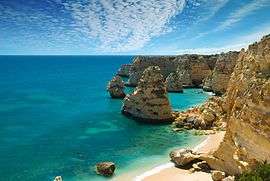Tourism in Portugal

.jpg)

Portugal attracts many tourists each year. In 2006, the country was visited by 7 million tourists.[1] Tourism is playing an increasingly important role in Portugal's economy contributing about 5% of the Gross Domestic Product (GDP).
The main tourist areas are, by order of importance, the Algarve, the Greater Lisbon (Lisboa), Greater Porto and Northern Portugal (Porto e Norte), city of Coimbra, Portuguese Islands (Ilhas Portuguesas: Madeira and Azores), and Alentejo.
Lisbon is, after Barcelona, the European city attracting most tourists, with 7 million tourists sleeping in the city's hotels in 2006, the number grew 11.8% compared to previous year.[2] Porto and Northern Portugal, especially the urban areas north of Douro River, was the tourist destination which grew most (11.9%) in 2006 and surpassed Madeira, in 2010, as the third most visited destination. Today, most tourists in Portugal are Spanish, British, French, Dutch, Scandinavians or Brazilians, which not only search for beach vacations, but mostly cultural ones, city breaks, gastronomy, nautical tourism or business traveling.
Portugal wins 14 "Oscars" of the tourism. The national tourism had 77 nominations and won a total of 14 awards in more than 10 European categories, surpassing Spain or Italy, at the gala of the World Travel Awards 2015, whose ceremony took place in Sardenha, Italy.
Tourism regions
Tourist hotspots in Portugal are Lisbon, Porto, the Algarve, Coimbra and Madeira, but the Portuguese government is currently developing new destinations: the Douro Valley, Porto Santo Island, and Alentejo.
Portugal has several other tourism regions such as Douro Sul, Templários, Dão-Lafões, Costa do Sol, Costa Azul, Planície Dourada, etc. Most of them are unknown to tourists and locals alike. As of 2007, these are being reorganized.
All these regions are grouped in tourism reference areas, which are widely known because these are the traditional regions:
- Costa Verde — The Portuguese green coast comprises all the northern coast of Portugal from the estuary of the Minho River to the city of Porto.
- Silver coast — The coast of central Portugal from Porto to Lisbon. Nazaré, Foz de Arelho and São Martinho do Porto are 3 important places at the Costa de Prata.
- Costa de Lisboa — Lisbon coast. The coast of the capital city and its important suburbs.
- Montanhas — Mountainous and interior regions of northern and central Portugal, namely Serra da Estrela and Trás-os-Montes.
- Planícies — The Portuguese plane region of Alentejo in the south.
- Algarve — The southern coast of Portugal.
- Madeira — The Madeira islands.
- Açores — The Azores islands.
Tourist regions

The main tourist regions can be broken-down into:
- the Greater Lisbon
- the Algarve,
- Greater Porto
- Northern Portugal (Porto and Norte), and
- the Portuguese Islands (Portuguese: Ilhas Portuguesas: Madeira and Azores), and Alentejo.
Other tourist regions include Douro Sul, Templários, Dão-Lafões, Costa do Sol, Costa Azul, Planície Dourada, that are unknown to many tourists or visitors.
Most of these regions are grouped in tourism reference areas, which continue to be in a state of reorganization and evolution, some based on the traditional regions of Portugal: the Costa Verde (Green Coast); Costa da Prata (Silver Coast); Costa de Lisboa (Lisbon Coast); Montanhas (Mountains); Planícies (Plains); Algarve; and the islands of the archipelagos of Madeira and the Azores.
The Rooster of Barcelos is bought by many tourists as a souvenir. The legend of the Rooster of Barcelos tells the story of a dead rooster's miraculous intervention in proving the innocence of a man who had been falsely accused and sentenced to death. The story is associated with the 17th-century calvary that is part of the collection of the Archeological Museum located in Paço dos Condes, a gothic-style palace in Barcelos, a city in the Braga District of northwest Portugal.
UNESCO World Heritage sites
See also
References
External links
- Portugal Official Tourism Website
-
 Portugal travel guide from Wikivoyage
Portugal travel guide from Wikivoyage -
 Media related to Tourism in Portugal at Wikimedia Commons
Media related to Tourism in Portugal at Wikimedia Commons